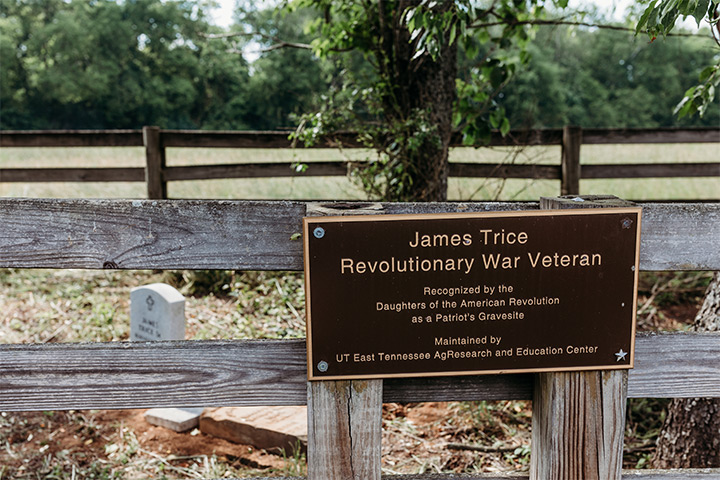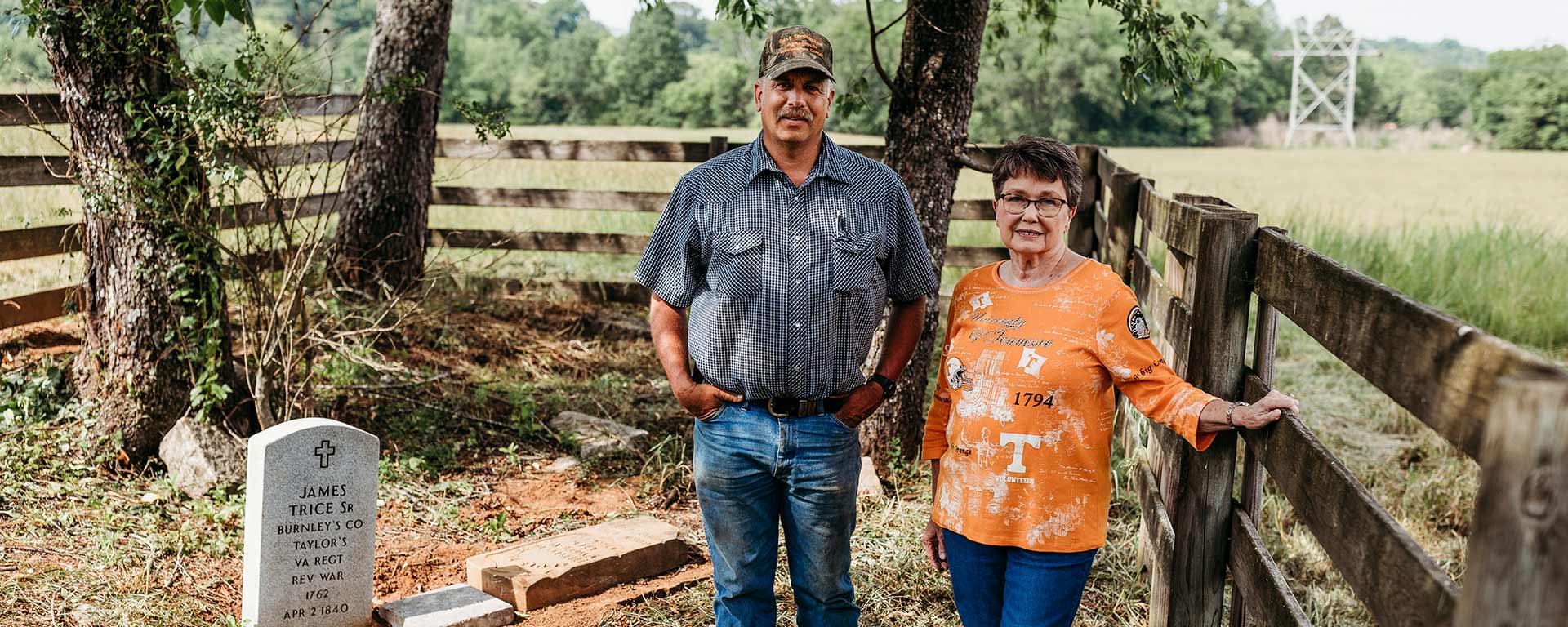Wild cherry trees sway over the grave of James Trice and dapple the ground below with shade. Birdsong and crickets’ chirps fill the air. The pastoral setting is fitting for trice, a revolutionary war veteran who is buried on land he once farmed.
Trice’s serene gravesite remains part of a farm. In fact, his small cemetery lies near the center of a 22-acre production field at a University of Tennessee Institute of Agriculture-owned farm. Known as the Blount Unit of the East Tennessee AgResearch and Education Center (ETREC), the property is the primary site of the center’s registered Angus cattle herd and home to livestock research, teaching and educational outreach that support one of the largest agricultural sectors in Tennessee.
The Blount Unit is located in the small community of Rockford, sited along a stretch of Alcoa Highway 8 miles from UT Knoxville’s campus.
Trice migrated to the area after serving in Burnley’s Company of Taylor’s Virginia Regiment, a regiment of guards on the Virginia line assigned to the Albemarle Barracks, where British prisoners were housed. Trice, a native of Louisa County, Virginia, enlisted in 1778 at age 16 and was discharged with the rank of private three years later after Albemarle prisoners were sent to Maryland.

In those days, two migration routes led from Virginia to Blount County, and Trice was one of many Revolutionary War veterans to make their way there. In 1809, the Tennessee General Assembly deeded Trice 217 acres of land in Rockford at a dollar an acre. He and his wife, Mary Smith, settled on a site overlooking the Little River, where they raised 11 children as well as cotton, wheat, corn and fodder, and hogs.
All these facts come from Trice’s living descendant and fifth great-granddaughter, Pat Hitson Reilly of Maryville. Reilly’s family never left Blount County, and when she began researching her family history, Reilly says she found quite the paper trail.
“Generations of my ancestors married in Blount County; they left wills and had death certificates, all of which record their lives,” she says.
In Trice’s case, Reilly found rich details in an 1844 estate sale inventory—four years after Trice’s death. Mary decided to leave Rockford to live with one of her sons. The inventory, written in longhand, lists who bought what and for what price, including 1,000 bundles of fodder, six lots consisting of 200 pounds of cotton each, numerous hogs, cattle and horses. Five hogs went for $10.75, and terms of 12 months’ time were offered on all sums over $5. An ad for the sale in the Knoxville Register newspaper describes the Trice house as a good brick residence with good barns and outhouses and fenced pastures. A son bought the house and the right for full use of the land for $1,900, and family members purchased many of the goods, with the farm remaining in the family for three more generations.
“Items in the inventory like silver teaspoons and tablespoons, a coffee mill and coffee pot, and the newspaper’s description of the house tell me that Grandpa Trice, as I call him, was fairly affluent. Not rich, but he was successful,” Reilly says.
From her research, Reilly knew that Trice’s grave was located on UT agricultural land. Then, in 2011, two ETREC employees contacted the Mary Blount Chapter of the Daughters of the American Revolution to ask if Trice had a living descendent. Members quickly identified Reilly.
“When Bobby Simpson and Brandon Beavers invited me to come to the farm and see the grave, I was thrilled. To be on the land my ancestors farmed was an incredible experience,” she says.
It was Simpson, the now-retired director of ETREC, who had a sturdy wooden fence installed around the gravesite. A broken headstone from 1931 marks the spot, as did older broken weathered stones that marked Trice’s life. Simpson worked with the university to obtain the bronze plaque mounted on the fence that proclaims the site the grave of a Revolutionary War veteran. Beavers, the farm manager of the Blount Unit, continues to assist Reilly in accessing the grave, and she has brought family there on Independence Day and Veterans Day.
In 2021, the Tennessee Valley Authority sent an archaeologist and historian to survey the land in preparation of installing transmission towers nearby, and Reilly joined them.
“The field slopes down to the Little River, yet there is an unnaturally flat area near the grave that looks leveled, and the archaeologist, Tracy Jenkins, told me that was where Grandpa Trice’s home likely was located,” Reilly says. “Tracy asked me if his house had glass windows. I said I didn’t know. He handed me a thin piece of broken glass he had found, the type of glass he said was used for panes in that era, and told me the house did have glass windows. Then he handed me a fragment of crockery from a china set. Holding it in my hand, knowing my ancestors dined from it and Mary washed it, was like electricity going through me.”
Beavers says he finds the grave interesting yet isn’t surprised by its presence.
“To me, it’s just a part of history and part of the farm. You find a lot of graves and historical artifacts on farms the world over because the land has not been developed. What I do wonder about is how much of the Trice land is contained in the 515 acres of this farm,” he says.
UT established the Blount Unit in 1943, purchasing the land of four farms. Reilly’s research indicates Trice’s farm followed the meanders of the Little River, as does the Blount Unit, so Trice’s 217 acres may well all lie within the boundaries of the UT farm.
ETREC is composed of the Blount Unit and five other agricultural units that span everything from dairy operations to row crops and bioenergy feedstocks. The AgResearch and Education Center is one of 10 field laboratories operated across Tennessee by the UT Institute of Agriculture. At these centers, scientists and students test their ideas and hypotheses under real-life conditions.
While the field laboratories’ areas of focus are highly diverse, the scientific studies are united in their goal to advance agricultural productivity and stewardship of environmental resources. These are important goals for a world with a spiraling need for food and increasingly scarce land on which to produce it.
This spring, the large field where Trice’s grave lies was planted in hay. In previous years, the field has been used to graze cattle and grow corn—all commodities that Trice produced on the land. Farming remains in the land’s past, present and future.



